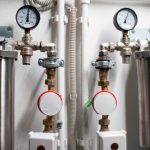Our Address:
Flooding is one of the most destructive natural disasters, not only because of the immediate damage it causes but also due to the long-term issues that can arise if water isn’t properly cleaned up. One of the most pressing concerns after a flood is mold growth. Mold can spread rapidly, posing health risks and leading to costly repairs if not addressed quickly. Fortunately, there are several steps you can take to protect your property from mold after a flood.
In this blog, we will discuss why mold grows after flooding, the health risks associated with mold, and the specific steps you can take to safeguard your home or business. Whether you’re located in St. Petersburg, Tampa, Clearwater, Largo, or any of the surrounding cities, this guide will help you minimize damage and keep your property safe.
Why Mold Growth Is a Major Concern After Flooding
Mold spores are naturally present in the air, but they require moisture to grow. After a flood, the increased humidity and dampness provide the perfect conditions for mold to thrive. Mold can start growing on wet materials, such as drywall, wood, insulation, carpets, and furniture, in as little as 24 to 48 hours after the floodwaters recede.
The most common types of mold that grow after flooding include:
- Aspergillus: Often found on damp walls and insulation.
- Cladosporium: Commonly grows on textiles, wood, and insulation.
- Stachybotrys: Also known as black mold, it thrives on cellulose-rich materials, like paper and wood.
These types of mold can cause extensive damage to building materials and contribute to poor indoor air quality.
Health Risks Associated with Mold
Mold exposure can have serious health consequences, especially for people with pre-existing respiratory conditions, allergies, or weakened immune systems. Some common symptoms of mold exposure include:
- Nasal congestion
- Coughing and wheezing
- Eye irritation
- Skin rashes
- Shortness of breath
- Asthma attacks in sensitive individuals
For those with mold sensitivities or compromised immune systems, long-term exposure can lead to more severe respiratory infections and other health issues.
Steps to Protect Your Property from Mold After a Flood
Now that we understand the risks, let’s explore how you can protect your property from mold after a flood.
1. Remove Standing Water Immediately
The first and most critical step in mold prevention is to remove standing water as soon as it is safe to do so. Mold thrives in wet environments, so the longer the water remains, the higher the likelihood of mold growth. Use pumps, wet vacuums, and buckets to remove water quickly. For large floods, it may be necessary to hire professional water extraction services to ensure complete removal.
2. Dry Out the Affected Areas
Once the standing water is gone, focus on drying out the property. This can be done with:
- Dehumidifiers: These devices are essential for removing moisture from the air and speeding up the drying process.
- Fans: Place high-powered fans throughout the affected areas to circulate air and aid in drying.
- Open Windows and Doors: If weather permits, open windows and doors to allow fresh air to circulate.
You may also need to lift carpets and remove water-soaked items such as furniture and drywall to prevent mold growth.
3. Remove Damaged Materials
Materials like carpeting, drywall, insulation, and furniture that have absorbed floodwater should be removed and discarded if they cannot be thoroughly dried within 24 to 48 hours. Porous materials are particularly susceptible to mold growth, and once mold starts growing on these surfaces, it can be difficult to completely eliminate.
Some materials you may need to discard include:
- Wet insulation
- Waterlogged drywall
- Flood-damaged carpets and padding
- Moldy wooden furniture
4. Sanitize and Disinfect Surfaces
Once the area is dry, it’s essential to disinfect all surfaces to kill any remaining mold spores. Use a mixture of water and bleach or a commercial mold-killing solution to sanitize floors, walls, and other surfaces that came into contact with floodwater. Be sure to wear protective gear, such as gloves and a mask, when handling these cleaning solutions.
5. Monitor Humidity Levels
After the initial cleanup, continue monitoring humidity levels inside your property. Mold thrives in environments with high humidity, so it’s important to keep indoor moisture levels under control. Use a hygrometer to measure the humidity, and aim to keep it below 50%.
If the area is particularly prone to dampness, consider installing a permanent dehumidifier in basements or other vulnerable areas. Ensuring good ventilation can also help reduce moisture buildup.
6. Inspect for Mold Growth Regularly
Even after taking all the necessary precautions, mold can still develop. Regularly inspect areas that were affected by the flood, paying close attention to hidden spaces like behind walls, under floors, and inside HVAC systems. If you notice any signs of mold, such as musty odors, discoloration on surfaces, or visible mold growth, act quickly to address the problem.
When to Call in Professionals
In some cases, despite your best efforts, mold may still take hold after a flood. If the affected area is large or mold growth is extensive, it’s best to call in professionals. A professional mold remediation service will:
- Conduct a thorough inspection of your property
- Remove all mold-contaminated materials
- Disinfect affected areas
- Ensure proper ventilation and drying
If you’re located in St. Petersburg, Tampa, Clearwater, or other nearby cities, CIS Solutions is your trusted partner in flood restoration and mold remediation. We have the expertise and equipment to address flood damage and prevent mold growth effectively.
Cities We Serve
We proudly offer water damage restoration and mold remediation services in:
- St. Petersburg
- Tampa
- Clearwater
- Largo
- Palm Harbor
- Seminole
- Pinellas Park
- Gulfport
Contact CIS Solutions Today
For professional flood restoration and mold remediation services, contact CIS Solutions. Our team is available 24/7 to respond to emergencies and protect your property from mold damage.
- Location: St. Petersburg, FL
- Phone: (727) 797-5205
- Website: cis-advantage.com
Don’t wait until it’s too late. By acting quickly and working with experienced professionals, you can protect your property and health from the risks associated with mold growth after a flood. Visit cis-advantage.com for more information and to request help today.





